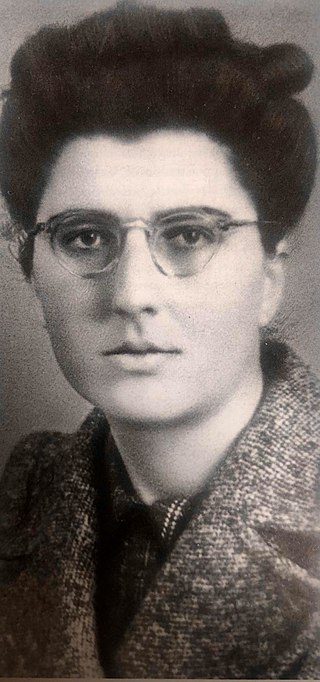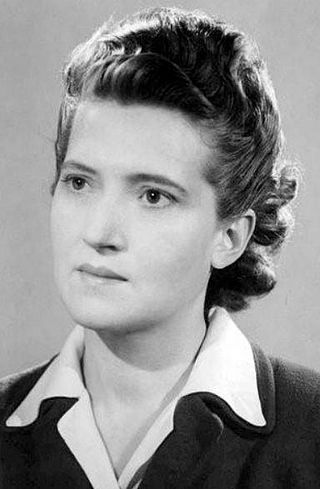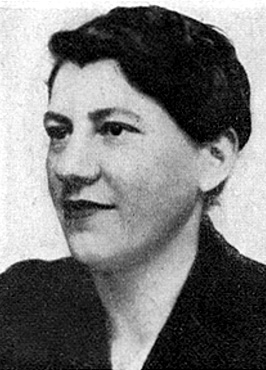
Charlotte Delbo was a French writer chiefly known for her haunting memoirs of her time as a prisoner in Auschwitz, where she was sent for her activities as a member of the French Resistance.

Germaine Tillion was a French ethnologist, best known for her work in Algeria in the 1950s on behalf of the French government. A member of the French resistance, she spent time in the Ravensbrück concentration camp.

Marie-Claude Vaillant-Couturier was a member of the French Resistance as well as a photojournalist, Communist and later, French politician.
Rose Warfman was a French survivor of Auschwitz and member of the French Resistance.

Danielle Casanova was a French communist activist and member of the French Resistance during World War II. A dentist by occupation, she was a high-ranking figure within the Communist Youth and founded its women's organisation Union des Jeunes Filles de France in 1936. Casanova was arrested on 15 February 1942 as she brought coal to Georges Politzer and his wife; she had been involved in organising actions against the German occupiers. First incarcerated at La Santé Prison in Paris, she was transferred to the Fort de Romainville for causing unrest with the help of fellow prisoners. Casanova was deported to Auschwitz on 24 January 1943, where she began working as a dentist at the camp infirmary. She died of typhus shortly thereafter. She was posthumously awarded the Legion of Honour.
Bereck Kofman was a French Hasidic orthodox rabbi, independent from the consistory, born in Poland, deported and murdered in Auschwitz.

Women in the French Resistance played an important role in the context of resistance against occupying German forces during World War II. Women represented 15 to 20% of the total number of French Resistance fighters within the country. Women also represented 15% of political deportations to Nazi concentration camps.

Madeleine Passot was a French communist who worked for the French Resistance as a liaison agent during World War II (1939–45). She was arrested and deported to the Auschwitz concentration camp, but survived the war and returned to France. She became Madeleine Jégouzo by marriage in 1947.

Laure Gatet was a French pharmacist, biochemist, and a spy for the French Resistance during World War II.

Denise Vernay-Jacob was a member of the French Resistance during World War II, who operated under the aliases of "Miarka" and "Annie" from 1941. She narrowly avoided the March 1944 roundup of Jews in Nice, France which resulted in the deportation of her parents to Auschwitz concentration camp in occupied Poland. Captured less than three months later, she survived torture by the Gestapo and imprisonment at two Nazi concentration camps – Ravensbrück and Mauthausen. She was rescued by the Red Cross in April 1945 and returned home to France at the conclusion of the war.
Yvonne Picard was a French philosopher and a member of the French Resistance during the Second World War. She and her brother, the historian Gilbert Charles-Picard, were the children of the archaeologist Charles Picard.

The rue Sainte-Catherine Roundup was a Nazi raid and mass arrest of Jews in Lyon's Sainte-Catherine street by the Gestapo. The raid, ordered and personally overseen by Klaus Barbie, took place on 9 February 1943 at the Fédération des sociétés juives de France, then located at the number 12 of this street. To catch as many people as possible, the Nazis not only chose the day the Federation normally gave free medical treatment and food to poor Jewish refugees, but they also set up a trap by forcing arrested Federation employees to encourage further people to come to the 12 rue Sainte Catherine.

Maisie Renault was a French Resistance fighter, a member of the Confrérie Notre-Dame network, she was arrested in 1942 and deported to the Ravensbrück concentration camp in 1944.

Adélaïde Haas Hautval was a French physician and psychiatrist who was imprisoned in Auschwitz concentration camp, where she provided medical care for Jewish prisoners and refused to cooperate with Nazi medical experimentation. She was named Righteous Among the Nations in 1965.
Simon Gutman was a Polish-born French Holocaust survivor.
Rose Guérin was a French politician. She was elected to the National Assembly in 1945 as one of the first group of French women in parliament, serving in parliament until 1958.

Hélène Solomon-Langevin was a French politician. She was elected to the National Assembly in 1945 as one of the first group of French women in parliament.
The Convoi des 31000 or Convoy of the 31000s was a deportation convoy that left Romainville, France, for Auschwitz Concentration Camp on 24 January 1943. The women who were transported were mostly Communist Party members or Resistance fighters. Its name stemmed from the fact that the women were assigned numbers between 31625 and 31854 when they reached Auschwitz. It was the only convoy to transport women of the French Resistance to Auschwitz. Out of 230 women who arrived at the concentration camp, only 49 survived their ordeal. A number of women from the convoy testified against the Nazis after the war, wrote autobiographies, were awarded the Legion of Honour or were decreed to be Righteous Among the Nations.
Convoy n° 77 of July 31, 1944 the last large convoy of Jews deported from the Drancy internment camp to the Bobigny train station for the Auschwitz-Birkenau extermination camp.
Gilberte Louise Champion was a Postes, télégraphes et téléphones (PTT) worker and a radio operator in the French resistance during World War II for the Jade-Fitzroy network under the auspices of the British Secret Intelligence Service (SIS). She was captured, tortured and later transported to Ravensbrück and Mauthausen concentration camps.












